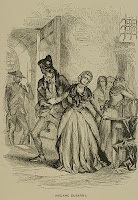Yes, diamonds. What is this crap?
| The Newark Cocktail |
Therefore, I am very happy to have discovered this enchanting, autumnal libation. It's woodsy, complex, a bit smoky, and has a hint of apple. It is the flavor equivalent of kicking through fallen leaves in an orchard, the odor of burning wood wafting through the bracing air, the last bite of apple still on the tongue. I've only made two and I am in love. If you like a Manhattan, you will probably enjoy this. It's worth having to buy the Fernet-Branca you'll need.
The cocktail is called the Newark, evidently, because it is a variation on the classic Brooklyn Cocktail - and according to the recipe, its creators (Jim Meehan and John Deragon of New York's Please Don't Tell) "didn't think the world needed another Park Slope cocktail. So they looked across the Hudson River instead and cheekily named it the Newark."
The cocktail is called the Newark, evidently, because it is a variation on the classic Brooklyn Cocktail - and according to the recipe, its creators (Jim Meehan and John Deragon of New York's Please Don't Tell) "didn't think the world needed another Park Slope cocktail. So they looked across the Hudson River instead and cheekily named it the Newark."
It is a most fitting name, too, since Laird's apple brandy and applejack (apple brandy blended with neutral spirits, somewhat similar to bourbon or rye, except apples are used instead of corn, wheat, or rye) have been distilled in good ol' New Jersey since 1780.
The Newark Cocktail
Bottoms up!
The Newark Cocktail
- 2 oz Laird's applejack (or Laird's 100-proof, bottled in bond apple brandy - if you can find it)
- 1 oz sweet vermouth (if you can find them, Carpano Antica or Vya add delicious nuances here)
- 1/4 oz Fernet-Branca
- 1/4 oz maraschino liqueur (I use Luxardo)
Bottoms up!


